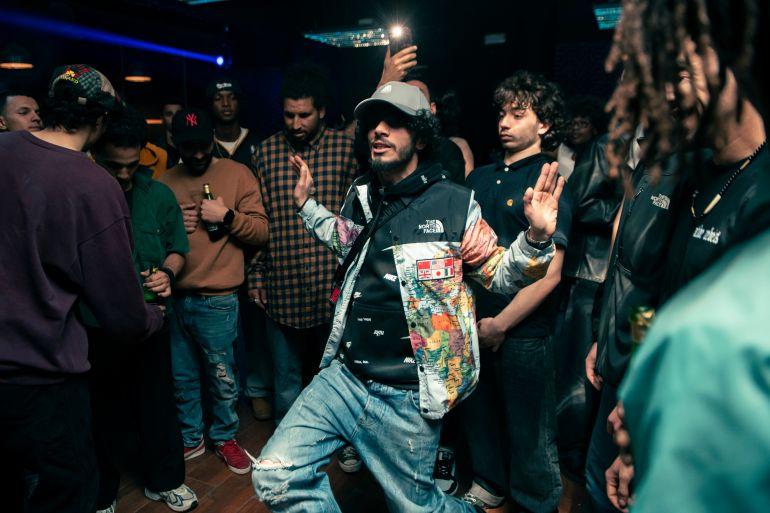Source: ALJAZEERA
ALJAZEERA MEDIA NETWORK

A surge in breakdance competitions and contemporary dance is driving a cultural revival in Tunisia.
Tunis, Tunisia – On a warm Thursday evening in Tunis, the trendsetters of the region are heading away from the city centre to the nightlife district of Gammarth, spearheading Tunisia’s cultural revival.
The main event of the night is a hotly anticipated “breakdance battle”.
The venue, Lazy Club Tunis, exudes a charmingly rundown vibe – beer bottles leaned against walls, broken club decor piled in corners; cracked chairs, shattered crates, and a microphone lies abandoned on a table.
As we arrive at the dance floor, small groups have already gathered, onlookers push on the sidelines, the music growing louder as the crowd focuses on a central point.
My view is partially obstructed; I catch glimpses of a trainer or an arm rising above the throng, retreating quickly with cheers celebrating the swift acts. As I edge closer to the front, I grasp why the audience is so captivated.
A lone dancer commands the makeshift stage. His sequence of intricate footwork and acrobatic flips keeps the crowd enthralled, inching closer. Another competitor emerges, circling the crowd, hyping himself up.
The performer is 25-year-old Oussema Khlifi, a civil engineering graduate from the Higher Institute of Technological Studies, Rades University in Tunis, who has chosen a creative path in breakdancing over his academic career.
![Oussema Khlifi, 25, practises his breakdancing skills in Tunis [Courtesy of Native Rebels]](https://nowtrends.net/storage/2024/06/H7J5ZKD9O06Q_32WMA2S49PN6.jpg) Oussema Khlifi, 25, practises his breakdancing skills in Tunis [Courtesy of Native Rebels]
Oussema Khlifi, 25, practises his breakdancing skills in Tunis [Courtesy of Native Rebels]
We meet again a few days later at a bohemian cafe in La Marsa, an affluent neighborhood adorned with chic attire in boutique storefronts. Fresh-faced Khlifi approaches in baggy jeans and a bucket hat.
His friend, 29-year-old hip-hop and contemporary dancer Hazem Chebbi, arrives later. Sporting a buzzcut and thick moustache, Chebbi, known for his agility, is a regular at the Opera Theatre in Tunis.
Chebbi shares how he grew up in rural Tozeur with no cultural or dance programs. “I only started dancing after watching the film, Step Up,” he admits, laughing about rehearsing dance scenes from the movie alone in his bedroom and finding videos on YouTube to follow.
Similarly, Khlifi got hooked on breakdancing clips on YouTube, feeling isolated until discovering old videos of Tunisian breakdancers from the 1990s.
Seeing Seifeddine Mannai’s 1996 clip with Upperunderground made Khlifi realize a career in breakdance was possible.
“Many prominent Tunisian dancers left for Europe before the 21st century, hurting the local scene. We – the new generation – must revive it.”
After building a name locally, Chebbi was sought out by Syhem Belkhodja, owner of the Sybel Ballet Theatre, who's committed to fostering a dance renaissance.
Their passion for dance grew alongside the 2011 Arab Spring, inspiring cultural initiatives in art, theatre, and fashion.
![Hazem Chebbi performs on stage during a residency programme supported by Al Badil and the Gaspé Creation Diffusion Center in Canada [Courtesy of Erika Williamson]](https://nowtrends.net/storage/2024/06/0TIRF7966YMN_XRKAYLB0JLVT.jpg) Hazem Chebbi performs on stage during a residency programme supported by Al Badil and the Gaspé Creation Diffusion Center in Canada [Courtesy of Erika Williamson]
Hazem Chebbi performs on stage during a residency programme supported by Al Badil and the Gaspé Creation Diffusion Center in Canada [Courtesy of Erika Williamson]
Later on, I meet with dancer and choreographer Selim Ben Safia, 36, who recalls more conservative times before the revolution when male dancers faced criticism.
In 2007, performing in feminine attire caused significant anxiety, but post-revolution support from the Ministry of Culture in 2012 provided grants and validation for choreographers.
Performances of contemporary dance flourished. Chebbi found like-minded individuals through the Sybel Ballet Theatre.
Building a community was challenging for breakdancer Khlifi, who explains the communal nature of breakdance battles. Forming his crew, Native Rebels, in 2016 started small but now includes nine members he considers like brothers.
Cultural organizations like Room 95 and Al Badil emerged to promote the scene and host events spotlighting local talent.
Ben Safia is focused on reviving traditional Tunisian culture through dance, like in his notable piece “El Botiniere,” blending traditional cabaret with modern techniques.
The piece features rhythmic, sensual movements to music combining Arabic percussion and contemporary house beats, emphasizing Tunisia’s unique dance identity over Western norms.
There remain notable challenges. Afro-dancer Eya Ben Cheikh explains the struggle for visibility, with hip-hop and breakdance more favored in Tunisia.
Cheikh faces additional challenges as one of few women in a male-dominated dance community but remains proud of her accomplishments and hopes to inspire other women to join.
Turning a passion for dance into a career is difficult. When Chebbi began, he received minimal pay and free board, performing more shows for major festivals over time.
Khlifi finds earning a living from breakdancing challenging, supplementing his income by performing more popular contemporary and hip-hop styles and teaching dance classes.
Despite frustrations, Khlifi remains hopeful, noting the growing interest from a younger generation guarantees the dance community’s future in Tunisia.
Your email address will not be published. Required fields are marked *